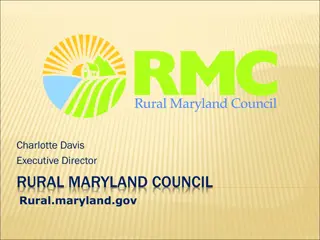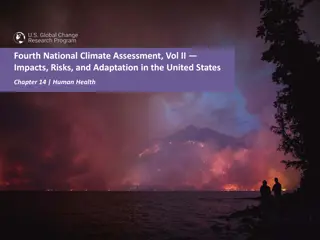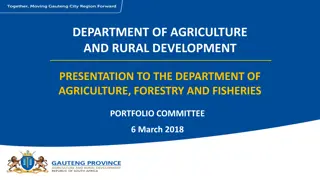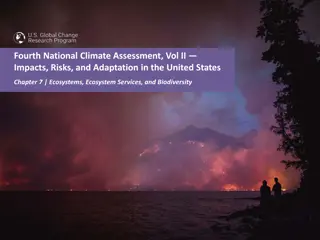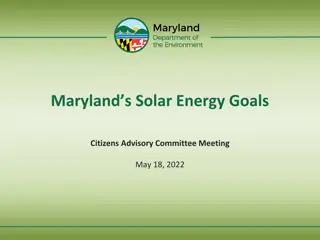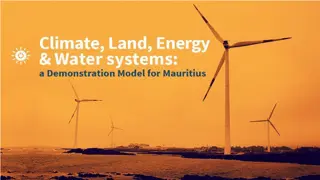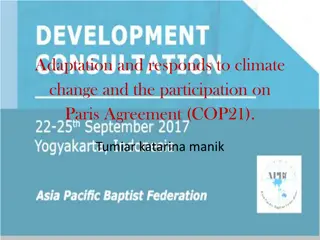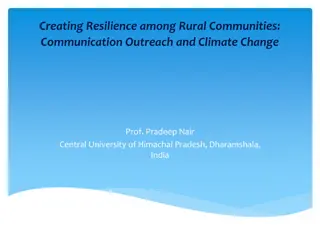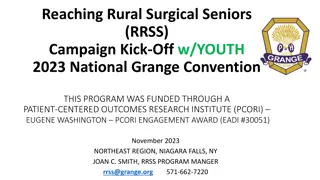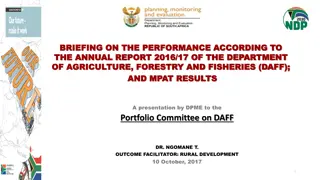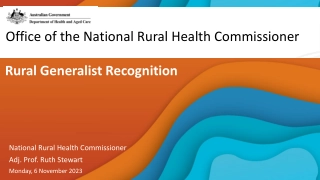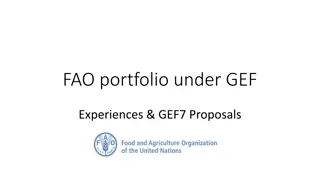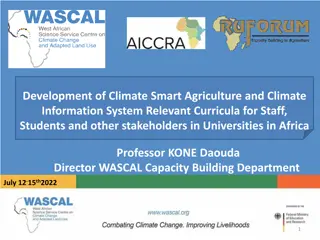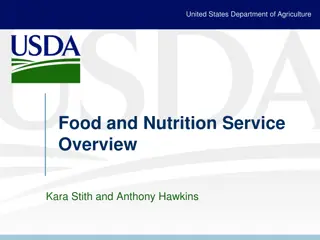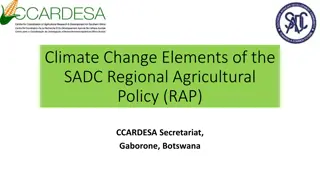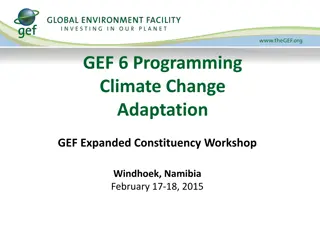Impacts of Climate Change on Agriculture and Rural Communities in the United States
The Fourth National Climate Assessment highlights the significant challenges faced by agriculture and rural communities in the United States due to climate change. Reduced agricultural productivity, degradation of soil and water resources, health challenges to both humans and livestock, and vulnerability of rural communities are key issues outlined in the assessment. Shifts in precipitation patterns, extreme weather events, and rising temperatures are identified as major drivers of these challenges, requiring adaptive strategies and sustainable practices to improve resilience and mitigate impacts.
Download Presentation

Please find below an Image/Link to download the presentation.
The content on the website is provided AS IS for your information and personal use only. It may not be sold, licensed, or shared on other websites without obtaining consent from the author. Download presentation by click this link. If you encounter any issues during the download, it is possible that the publisher has removed the file from their server.
E N D
Presentation Transcript
Fourth National Climate Assessment, Vol II Impacts, Risks, and Adaptation in the United States Chapter 10 | Agriculture and Rural Communities Fourth National Climate Assessment, Vol II Impacts, Risks, and Adaptation in the United States nca2018.globalchange.gov 1
Ch. 10 | Agriculture and Rural Communities Key Message #1 10 Reduced Agricultural Productivity Food and forage production will decline in regions experiencing increased frequency and duration of drought. Shifting precipitation patterns, when associated with high temperatures, will intensify wildfires that reduce forage on rangelands, accelerate the depletion of water supplies for irrigation, and expand the distribution and incidence of pests and diseases for crops and livestock. Modern breeding approaches and the use of novel genes from crop wild relatives are being employed to develop higher- yielding, stress-tolerant crops. Fourth National Climate Assessment, Vol II Impacts, Risks, and Adaptation in the United States nca2018.globalchange.gov 2
Ch. 10 | Agriculture and Rural Communities Key Message #2 10 Degradation of Soil and Water Resources The degradation of critical soil and water resources will expand as extreme precipitation events increase across our agricultural landscape. Sustainable crop production is threatened by excessive runoff, leaching, and flooding, which results in soil erosion, degraded water quality in lakes and streams, and damage to rural community infrastructure. Management practices to restore soil structure and the hydrologic function of landscapes are essential for improving resilience to these challenges. Fourth National Climate Assessment, Vol II Impacts, Risks, and Adaptation in the United States nca2018.globalchange.gov 3
Ch. 10 | Agriculture and Rural Communities Key Message #3 10 Health Challenges to Rural Populations and Livestock Challenges to human and livestock health are growing due to the increased frequency and intensity of high temperature extremes. Extreme heat conditions contribute to heat exhaustion, heatstroke, and heart attacks in humans. Heat stress in livestock results in large economic losses for producers. Expanded health services in rural areas, heat-tolerant livestock, and improved design of confined animal housing are all important advances to minimize these challenges. Fourth National Climate Assessment, Vol II Impacts, Risks, and Adaptation in the United States nca2018.globalchange.gov 4
Ch. 10 | Agriculture and Rural Communities Key Message #4 10 Vulnerability and Adaptive Capacity of Rural Communities Residents in rural communities often have limited capacity to respond to climate change impacts, due to poverty and limitations in community resources. Communication, transportation, water, and sanitary infrastructure are vulnerable to disruption from climate stressors. Achieving social resilience to these challenges would require increases in local capacity to make adaptive improvements in shared community resources. Fourth National Climate Assessment, Vol II Impacts, Risks, and Adaptation in the United States nca2018.globalchange.gov 5
Ch. 10 | Agriculture and Rural Communities Fig. 10.1: Agricultural Jobs and Revenue The figure shows (a) the contribution of agriculture and related sectors to the U.S. economy and (b) employment figures in agriculture and related sectors (as of 2015). Agriculture and other food-related value- added sectors account for 21 million full- and part-time jobs and contribute about $1 trillion annually to the United States economy. Source: adapted from Kassel et al. 2017.1 Fourth National Climate Assessment, Vol II Impacts, Risks, and Adaptation in the United States nca2018.globalchange.gov 6
Ch. 10 | Agriculture and Rural Communities Fig. 10.2: Population Changes and Poverty Rates in Rural Counties The figure shows county-level (a) population changes for 2010 2017 and (b) poverty rates for 2011 2015 in rural U.S. communities. Rural populations are migrating to urban regions due to relatively slow employment growth and high rates of poverty. Data for the U.S. Caribbean region were not available at the time of publication. Sources: (a) adapted from ERS 20182; (b) redrawn from ERS 2017.3 Fourth National Climate Assessment, Vol II Impacts, Risks, and Adaptation in the United States nca2018.globalchange.gov 7
Ch. 10 | Agriculture and Rural Communities Fig. 10.3: Changes in the Ogallala Aquifer The figure shows changes in groundwater levels in the Ogallala Aquifer from predevelopment to 2015. Source: adapted from McGuire 2017.163 Fourth National Climate Assessment, Vol II Impacts, Risks, and Adaptation in the United States nca2018.globalchange.gov 8
Ch. 10 | Agriculture and Rural Communities Fig. 10.4: Land Area and Extreme Precipitation The figure shows the percent of land area in the contiguous 48 states experiencing extreme one-day precipitation events between 1910 and 2017. These extreme events pose erosion and water quality risks that have increased in recent decades. The bars represent individual years, and the orange line is a nine-year weighted average. Source: adapted from EPA 2016.171 Fourth National Climate Assessment, Vol II Impacts, Risks, and Adaptation in the United States nca2018.globalchange.gov 9
Ch. 10 | Agriculture and Rural Communities Fig. 10.5: Projected Reduction in Milk Production The figure shows the predicted reduction in annual milk production in 2030 compared to 2010 in climate change induced heat stress. The regions are grouped according to USDA regional Climate Hubs (https://www.climatehubs.oce.usda.gov), and the colored bars show the four global climate models used. Source: redrawn from Key et al. 2014.83 Fourth National Climate Assessment, Vol II Impacts, Risks, and Adaptation in the United States nca2018.globalchange.gov 10
Ch. 10 | Agriculture and Rural Communities Chapter Author Team 10 Michael A. Grusak, USDA Agricultural Research Service Mark Boggess, USDA Agricultural Research Service Federal Coordinating Lead Author Carolyn Olson, U.S. Department of Agriculture Review Editor Georgine Yorgey, Washington State University Chapter Leads Prasanna Gowda, USDA Agricultural Research Service Jean L. Steiner, USDA Agricultural Research Service Chapter Authors Tracey Farrigan, USDA Economic Research Service Fourth National Climate Assessment, Vol II Impacts, Risks, and Adaptation in the United States nca2018.globalchange.gov 11
Ch. 10 | Agriculture and Rural Communities Acknowledgments 10 USGCRP Coordinators Susan Aragon-Long, Senior Scientist Allyza Lustig, Program Coordinator Fourth National Climate Assessment, Vol II Impacts, Risks, and Adaptation in the United States nca2018.globalchange.gov 12
Recommended chapter citation Gowda, P., J.L. Steiner, C. Olson, M. Boggess, T. Farrigan, and M.A. Grusak, 2018: Agriculture and Rural Communities. In Impacts, Risks, and Adaptation in the United States: Fourth National Climate Assessment, Volume II [Reidmiller, D.R., C.W. Avery, D.R. Easterling, K.E. Kunkel, K.L.M. Lewis, T.K. Maycock, and B.C. Stewart (eds.)]. U.S. Global Change Research Program, Washington, DC, USA. doi: 10.7930/NCA4.2018.CH10 Read the full chapter https://nca2018.globalchange.gov/chapter/agriculture-rural nca2018.globalchange.gov Fourth National Climate Assessment, Vol II Impacts, Risks, and Adaptation in the United States nca2018.globalchange.gov 13





